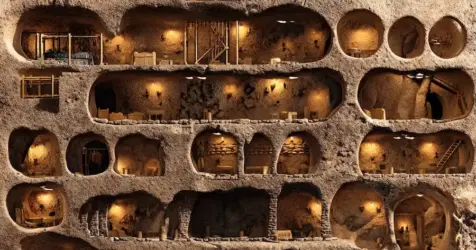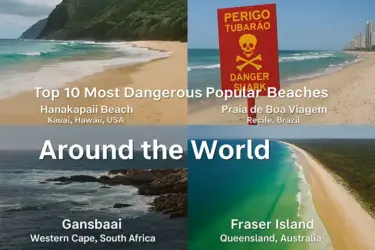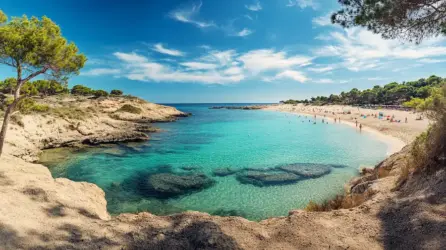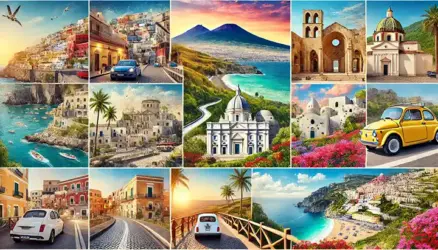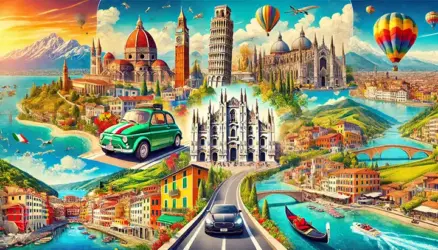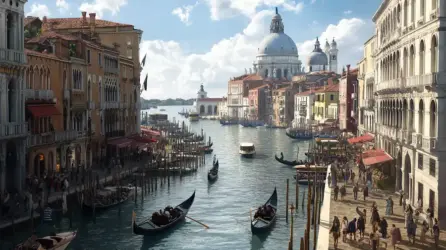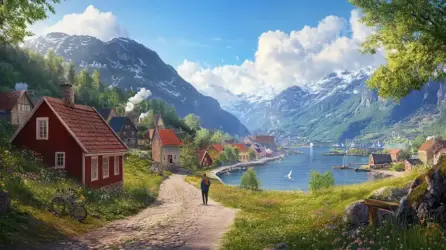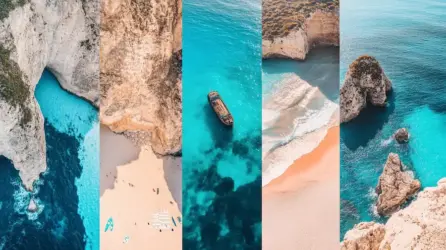Amalfi Coast – Attractions & Places to Visit

The Amalfi Drive (aka SS163) is one of the world’s most famous road trips, as well as arguably the most beautiful 48 kilometers of coastline in Italy, and is certainly high on the list of Italy’s top tourist attractions. The road clings high above the Tyrrhenian Sea, carved into cliffs already cut by deep ravines, in a series of breathtaking views and curves bounded by almost vertical mountains rising on one side and long vertical drops on the other.
You don’t have to drive it yourself, and you probably shouldn’t unless you’re familiar with Italian roads. One thing is certain: you won’t see much of the scenery if you drive. It’s not a place to take your eyes off the road for even a second, and there aren’t many places to pull over. Taking the bus is the most popular option. These buses run frequently and stop in towns, allowing you to get off, look around, go for a swim, have a coffee or lunch, and then get back on a later bus.
SITA buses run every hour or two, depending on the section of the route. The town of Amalfi is a popular stopping point, especially for travelers taking a two-day trip. Remember to take the bus from west to east, beginning in Sorrento, and try to get a window seat on the right side of the bus. If you’re driving, take the east-west route so you’re in the inside lane.
Use this handy visitors’ guide to the top Amalfi Coast attractions to plan your journey along this spectacular drive.
#1 Positano

The chic fashions and yacht-tanned people wearing them indicate that this westernmost town along the Amalfi Coast has clearly been discovered. When you see the flower-draped pastel houses tumbling down the steep hillside to the beach, it’s easy to understand Positano’s allure.
Apart from the 13th-century church of Santa Maria Assunta, with its majolica-tiled dome and Byzantine icon of a black Madonna (brought here by pirates, legend has it), the only sights to see are the narrow lanes near the port and possibly celebs sitting in the cafés.
More activities can be found at the Marina Grande, where you can rent rowboats, paddleboats, sailboats, Zodiacs, and motorboats, or join a cruise along the coast to Capri. The main draw of Positano’s Marina Grande, however, is the possibility of spotting a celebrity or two. To be where the action is, you’ll need to rent a lounge chair from one of the stabilimento balneare, beach clubs that also provide umbrellas, changing rooms, and refreshments. These are common on nearly all Italian beaches.
Positano’s long Fornillo Beach, which has a free area as well as the stabilimento, is not nearly as fashionable or good for spotting anyone important. Just east of Positano is trendy Praiano, which also has a tile-domed church, and not far beyond, the road crosses the deep and dramatic gorge of Vallone di Furore, one of the most popular photo stops on the Amalfi Drive.
#2 Amalfi

Amalfi is one of Italy’s most delightful places to visit, with its vertiginous streets, belvederes, cascading flowers, and ever-changing views of the blue sea below. Amalfi’s Marina Grande is almost as trendy as Positano’s, but the 200 meters of sand has free area at each end for those who don’t want to pay for a space with the smart set. This Marina Grande, like Positano’s, will be crowded.
With a geometric patterned façade, striped columns, and a dome resplendent in Majolica tiles, Amalfi’s cathedral, Duomo di Sant’Andrea, rises majestically at the top of a long staircase (nearly everything in Amalfi is reached by stairs). Climb the stairs to see the magnificent bronze doors, the ornate crypt with its frescoes, and the beautiful Chiostro del Paradiso, a cloister with a serene garden.
Continue up the hill to the intriguing Museo della Carta, where you can learn about Amalfi’s centuries-old paper-making industry and make your own paper using medieval techniques. This is one of the most popular things to do in Amalfi with kids.
#3 Grotta dello Smeraldo (Emerald Cave)

Stairs and an elevator descend to a marine cave near the village of Conca dei Marini. You might be wondering how stalactites formed in a sea cave, but this one wasn’t always at sea level. The cave formed higher, but the region’s volcanic activity (you’re not far from Vesuvius here) changed the sea and ground levels, causing the cave to wash in.
Sunlight shining through the water, similar to the Blue Grotto in Capri, gives it the appearance of being lit from within, in this case in an emerald-green glow. The water is so clear that you can see all the way to the bottom. Boats wait at the cave entrance to take you inside, or you can take a 15-minute boat ride from Amalfi’s beach to the cave.
#4 Villa Rufolo

The gray stone tower opposite the cathedral serves as the entrance to a villa whose gardens and terrace views inspired Wagner’s Parsifal’s magical garden of Klingsor. The villa began as a fortified manor house/farm in the 13th century and grew with successive generations until it was said to have more than 300 rooms (likely an exaggeration).
The 30-meter stone watchtower is the oldest part still standing. A Neo-Moorish cloister was added in the 18th century, and the grounds were transformed into Romantic gardens in the 19th century. The majority of the buildings are now in ruins and have been incorporated as garden features. Restored areas are used for art exhibits, and the grounds host concerts and an outstanding summer music festival featuring world-class performers and orchestras.
#5 Ravello

A winding road (SS 373) climbs through orange groves from Atrani, just east of Amalfi, to Ravello, an old town in a superb location overlooking the sea from the edge of the deep Valle del Dragone (Valley of Dragons). The lush gardens that once surrounded its villas have been transformed into parks, each with a better view than the last.
You might be surprised by the number of churches in such a small town, but it, like Amalfi, was once much larger. It had a population of 36,000 in the 13th century, and it had churches, monasteries, villas, and palaces. A mosaic pulpit decorated with Persian majolica can be found in the 12th-century church of San Giovanni del Toro, which has been remodeled in Baroque style; frescoes depicting scenes from Christ’s life can be found in the crypt.
The Romanesque Cathedral of San Pantaleone, begun in 1086 and remodeled in Baroque style, is located in the town center, and its bronze doors, like those in Amalfi and Atrani, were cast in Constantinople. Inside, there are two magnificent marble pulpits, both intricately inlaid. One design features mythical creatures and biblical scenes.
The Sentiero Atrani, a long steep set of steps winding through lemon groves and past breathtaking views, leads back to Amalfi. Give yourself at least 90 minutes.
#6 Find the Best Beach

The Amalfi Coast has a wide variety of places to swim and sun, with more than a dozen popular beaches and more hidden in coves only accessible by boat. Take advantage of this wealth by locating the beach that is ideal for you.
Choose the Marina Grande in Positano if you want to go all out. Celebrity spotting is a popular pastime in this town, and you’ll feel right at home in your new designer bathing suit. You can also sit and watch the parade while wearing large sunglasses. Rent a lounger at Amalfi’s Marina Grande, which is less upscale but has the same vibe.
Because of the orientation and irregularities of the coast, most beaches only receive morning sun. For afternoon sun, visit Arienzo Beach in Positano or the beaches of Cetara, Maiori, or Vietri sul Mare. Families looking for sand and shallow water for their children to play in should visit Maiori’s long, wide beach, one of the few with sand rather than pebbles.
Head to Erchie Beach for some scenery while you sunbathe, which is located beneath a charming fishing village with a medieval tower. Another postcard-worthy scene can be found at Marina di Cetara and, especially at sunset, at Gavitella beach, with colorful Positano in the background and islands rising from the sea on the horizon.
#7 Villa Cimbrone Gardens

Villa Cimbrone is located past the church of San Francesco, which has a Romanesque cloister, and the church of Santa Chiara. Through its beautiful park, an avenue leads to the Belvedere Cimbrone, which offers unparalleled views of the Amalfi coast.
Step away from the promenade to discover flower gardens hidden behind walls and a diverse collection of bits and pieces – statues, fountains, columns, temples, well heads, and architectural elements – brought here from ruins in the area and beyond. These were collected by the English lord who purchased the villa in 1904 and incorporated into the gardens in unique ways among the greenery and flowers.
#8 Salerno

The ancient Salernum, now Salerno, is located at the eastern end of the Amalfi peninsula, where the hills drop steeply into the Gulf of Salerno. During World War II, Salerno was the seat of the Fascist government. Following bombing and the allied invasion in 1943, all that remained was the partially ruined Castello di Arechi on a hill northwest of town; a few arches of a Roman aqueduct; and the cathedral, the only sight of particular interest to tourists.
The Cathedral of San Matteo, built around 1080 and restored in 1768 and again after 1945, houses the remains of the Evangelist Matthew, brought here from Paestum, and is one of Italy’s most important holy relics. The magnificent bronze doors were made in Constantinople in 1099 and depict St. Matthew in a mosaic above the doorway.
A flight of stairs leads up to a courtyard with 28 Paestum columns and 14 sarcophagi scavenged from the ancient site. In the nave, look for the two 12th-century pulpits with complicated mosaic decoration and an Easter candlestick in a similar style.
The ornate tomb of Margaret of Anjou (1412) is at the end of the north aisle, and the tomb of Pope Gregory VII, who died in Salerno in 1085, is in the chapel to the right of the high altar. Mosaics adorn the choir screens and the floor. If you don’t plan on going to Paestum after seeing the cathedral, the Museo Archeologico has some local antiquities worth seeing.
#9 Vallone delle Ferriere

To get away from the beaches, one of the most unusual things to do on the Amalfi coast is to hike through the deep valley named after the medieval foundries, the ruins of which can be seen here. The trail starts inland in Pontone, then heads off the road to Ravello before ending six kilometers later in Amalfi. As you approach Amalfi, you’ll see water mills that once powered the town’s paper-making industry.
The trail is relatively easy, descending through chestnut forests and past stands of rare ferns alongside a stream with several waterfalls. The valley is protected from harsh winter winds and intense summer heat by steep ridges on each side, creating a temperate and humid microclimate where rare plants thrive, some of which date back to the pre-glacial era. The trail’s central section passes through a nature preserve.
#10 Walking the Sentiero degli Dei

Another option for seeing the coast, and the best for those in good physical shape and with the time, is to walk or take a combination of walking and bus travel. Walking paths, stone stairways, and ancient mule paths wind along the coast, passing through forests, lemon groves, wildflowers, and tiny villages, with almost constant views of the sea. You can stop at any time to take pictures, eat a picnic, or simply enjoy the scenery.
The Sentiero degli Dei, or Footpath of the Gods, on the western end from Positano is the most beautiful section of trail – and that’s a tall order here. For independent walkers, several outfitters will arrange lodging and luggage transfers, or you can join a week-long group walking tour.

